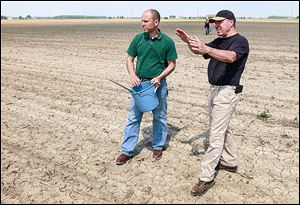
OSU PROGRAM
Extension celebrates centennial of service
5/26/2014
Eric Richer, Ohio State Extension educator, left, talks to Metamora farmer Keith Truckor on his 65 acres of corn crop, where he took nitrogen samples.
WAUSEON — They come with bugs in jars.
What is it? they ask.
They bring in the fungus among us.
Is this safe to eat?
They call. Just ran out of buttermilk. What can I use as a substitute?
Extension educators provide answers every day, just as it has been since the Cooperative Extension Service was created 100 years ago.
The Smith-Lever Act established the service in 1914. Extension roots were cultivated five decades earlier.
In 1862, the Morrill Act created land-grant universities in each state to provide practical education in agricultural and mechanical fields. Then, 25 years later, the Hatch Act established funding for land-grant universities to operate agricultural experiment stations and conduct research related to agriculture and rural life.
However, 2014 marks the 100th year of Extension because Smith-Lever formalized the outreach already taking place, extending the knowledge generated at land-grants and supporting it with cooperative funding from the federal, state, and county levels.
The core of Extension focuses on enhancing agriculture and the environment, strengthening families and communities, advancing employment and income opportunities, and preparing youth for success. The program today is known as Ohio State University Extension.
Times change, of course, but Extension’s people-to-people emphasis remains, said Eric Richer on a recent afternoon before heading out to meet a farmer in the Metamora area where a phosphorous field study is being conducted, research that could help the Great Lakes.
Mr. Richer is the Extension Educator, Agriculture and Natural Resources, in Fulton County. Extension offices are at 8770 State Rt. 108, nearly across from the Fulton County Fairgrounds near Wauseon.
In the office of Jill Stechschulte, extension educator, 4-H Youth Development, for 19 years in Fulton County, camp season brings out large sheets of paper that get covered with to-do lists.
A meeting for camp counselors was slated for that evening, and she was still catching her breath from the 4-H Cowgirl Princess Camp held recently at 4-H Camp Palmer near Fayette. The sixth annual camp, a hands-on learning experience, was hosted by 4-H Extension staff members Teresa Johnson of Defiance County; Laura Rohlf, Henry County; Staci Hiler, Paulding County, and Mrs. Stechschulte.
For 4-H members — Fulton County has averaged about 1,000 members annually for nearly 20 years — the learning process itself is as important, if not more so, than a blue ribbon on a fair project.
And no, Mrs. Stechschulte isn't going to do your homework. She will lead, she will guide, but it is up to each 4-H member to show up for meetings, to complete project requirements, and to be responsible for the outcome. Choices, consequences.
Mrs. Stechschulte grips the arms of her office chair. Her face scrunches into a grimace.
It‘s tough, it’s painful, but “I will let them fail,” she said. “I do not let them off the hook.”
The goal is for the young men and women to take their skills, and their self-confidence and self-esteem, into the real work-a-day world. 4-H is the largest youth organization in the county, she said. “The whole process builds the whole child.”
A goal as Extension celebrates its century mark is to provide the opportunity to broaden people’s understanding and awareness of what the program offers.
Amy Stone, extension educator for agriculture and natural resources in Lucas County, said Extension programs are more relevant today because there is such a tremendous desire for information in an instant.
With an abundance of information at hand, and with information anybody with a keyboard can post, extension educators offer area residents opportunities to obtain information that has been studied, looked at, observed, and is not just somebody’s opinion, she said.
That, she said, is particularly important when questions or issues arise about food safety or treating pest problems, for instance. “You want things that work,” she said.
Lucas County Extension will hold a celebration, complete with cake and healthy alternatives, July 8 as part of opening ceremonies of the Lucas County Fair.
Taking it to the people remains a tradition.
On a recent afternoon, Mr. Richer drove to the test field near Metamora.
At one time, Ohio Agricultural Extension traveled by train, showing off agricultural exhibits and offering presentations on modern farm practices. In 1911 alone, 16 trains made 418 stops and reached more than 45,000 Ohioans. Today, Extension staff provide information not only in person but through county and statewide Web sites and various social media.
With an office in every county, OSU Extension is the official outreach arm of Ohio State University’s college of food, agricultural, and environmental sciences, with additional faculty and staff in the college of education and human ecology and the college of veterinary medicine.
The college is spearheading a Conversation on the Future of OSU Extension to develop a vision for the organization’s second century. To take part in an online survey visit osu.edu/Ohio2035.
Contact Janet Romaker at:jromaker@theblade.com or 419-724-6006.